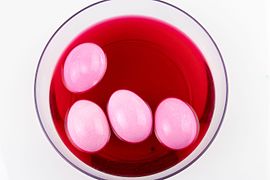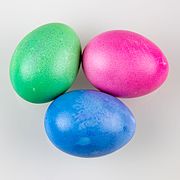Coloring Easter eggs
Easter egg paints are used for coloring Easter eggs . Different techniques are used to decorate, decorate and paint the eggs, but also different dyeing techniques and colorants .
Although the use of natural dyes is possible, the use of synthetic dyes has not yet been dispensed with for reasons of durability and lower prices .
Synthetic Easter egg colors
For coloring Easter eggs, so-called cold colors are available in tablet form, which are dissolved in water and a tablespoon of vinegar , dye sticks, which are used to dye eggs that are still hot, and Easter egg dye cloths. With these synthetic coloring tablets, sticks or cloths you get strong and bright colors.
They usually contain the following food colors :
| yellow | red | green | blue | |
|---|---|---|---|---|
| Coloring tablets | E 104 quinoline yellow | E 110 yellow orange S , E 122 azorubine | E 132 indigo carmine | |
| Dye sticks | E 104 quinoline yellow | E 122 Azorubine | E 142 green p | E 131 patent blue V |
| Dye cloths | E 100 curcumin | E 127 erythrosine | E 131 patent blue V |
Food colors are considered food additives and are therefore marked with a so-called E number .
Many of these dyes belong to the group of azo dyes , such as azorubine. In contrast, patent blue belongs to the group of triphenylmethane dyes . After ingestion, it is excreted unchanged and not absorbed by the body . Quinoline yellow and erythrosine are less absorbed.
The red dye carminic acid ( cochineal , food dye E 120) is a chemically processed natural dye and is obtained from the Kermes scale insect ( Porphyrophora polonica ) , among other things . The dye is the glycoside of an anthraquinone derivative . It is quite expensive and is therefore used less often. The artificially produced substitute cochineal red A is approved as a food color E 124.
- Coloring eggs with coloring tablets
Dyeing with dye cloths
Easter egg colors made from natural dyes
Coloring eggs with natural dyes is a traditional method that many vegetable dyes can be used to. The effort is somewhat greater for the user than with coloring tablets, and the duration of the coloring process requires a longer time. The colors appear a little less brilliant.
| yellow | brown | red | green | blue |
|---|---|---|---|---|
| Onion peel | tea | Onion with vinegar | spinach | Mallow flowers |
| saffron | onion | Beetroot | Nettle | |
| Alder bark | Oak bark | Red cabbage juice | Ivy leaves | |
| Caraway seed | Plum tree bark |
The dyes are boiled and the brew (the cooking water) is used as a dye bath. Adding vinegar makes the colors more intense. The boiled eggs are placed in the dye bath and must stay in it for about an hour.
The betanin found in beetroot (E 162 berry red) is sensitive to light and heat, but is still suitable for coloring. The infusion of nettles and spinach contains chlorophyll (E 140) as a coloring . This dye is soluble in water and fairly persistent.
Industrially colored eggs
Not only at Easter, but all year round, colored, hard-boiled eggs are available in stores under names such as “Brotzeit-Eier” or “Party-Eier”. The synthetic or natural substances permitted for their coloring are limited in Article 2 Paragraph 9 of EU Directive 94/36 / EC. The eggs are coated with non-toxic, food-safe shellac (E 904) to ensure a longer shelf life and a beautiful shine .
If the eggs are of organic quality , no dyes at all may be used in commercial coloring, only coloring foods . In this case, the state authorities are allowed to grant exceptions for the use of dyes from natural sources for a limited time - such as Easter time.
literature
- Heitmann’s egg colors (information on the ingredients on the packaging)
- Hans Fasold: Colorful Easter eggs. 17th edition, Christophorus-Verlag Herder, Freiburg im Breisgau 1966, ISBN 3-419-52324-6
- Werner Baltes : Food chemistry. 4th edition, Springer Verlag 1995, pp. 187-192, ISBN 3-540-58986-4
- Ökotest April 2015, Ökotest Verlag GmbH Frankfurt a. M.
- Stiftung Warentest: March 2009 Egg colors: Easter without harmful substances.
Individual evidence
- ↑ a b Dr. Andreas Miller Bavarian State Office for Health and Food Safety: Food: Colorful eggs - not just for Easter - Internet offer. Retrieved March 4, 2017 .
- ↑ Der Tagesspiegel, March 16, 2008: "High season in the chicken coop" [1]








